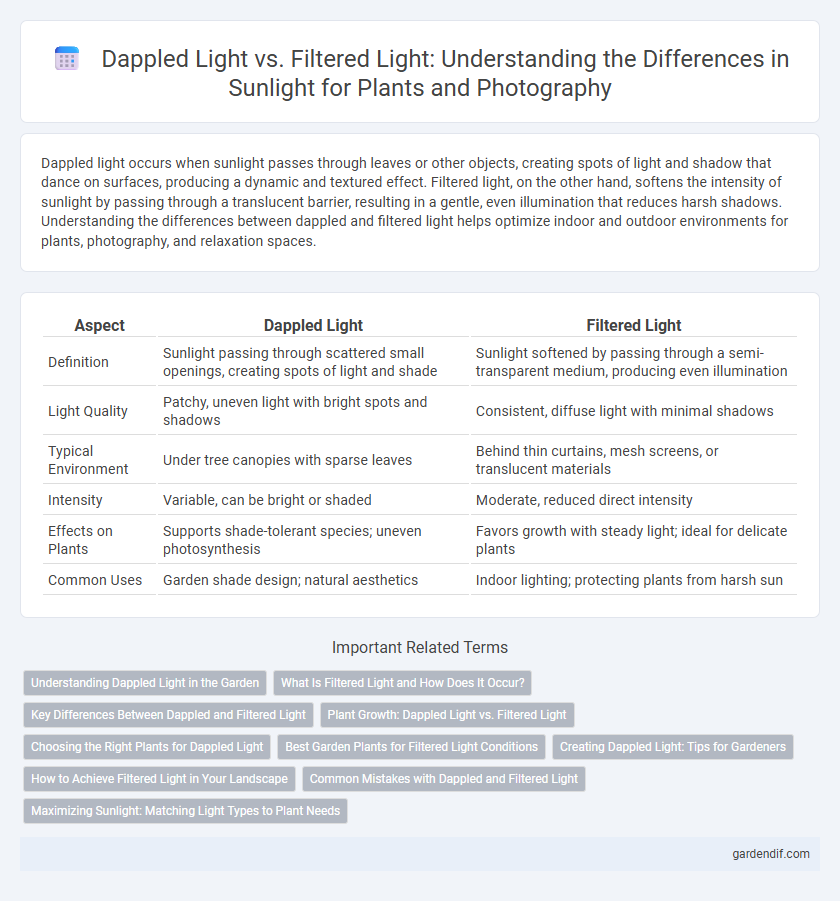
Dappled light vs filtered light Illustration
Dappled light occurs when sunlight passes through leaves or other objects, creating spots of light and shadow that dance on surfaces, producing a dynamic and textured effect. Filtered light, on the other hand, softens the intensity of sunlight by passing through a translucent barrier, resulting in a gentle, even illumination that reduces harsh shadows. Understanding the differences between dappled and filtered light helps optimize indoor and outdoor environments for plants, photography, and relaxation spaces.
Table of Comparison
| Aspect | Dappled Light | Filtered Light |
|---|---|---|
| Definition | Sunlight passing through scattered small openings, creating spots of light and shade | Sunlight softened by passing through a semi-transparent medium, producing even illumination |
| Light Quality | Patchy, uneven light with bright spots and shadows | Consistent, diffuse light with minimal shadows |
| Typical Environment | Under tree canopies with sparse leaves | Behind thin curtains, mesh screens, or translucent materials |
| Intensity | Variable, can be bright or shaded | Moderate, reduced direct intensity |
| Effects on Plants | Supports shade-tolerant species; uneven photosynthesis | Favors growth with steady light; ideal for delicate plants |
| Common Uses | Garden shade design; natural aesthetics | Indoor lighting; protecting plants from harsh sun |
Understanding Dappled Light in the Garden
Dappled light in the garden occurs when sunlight filters through the leaves of trees, creating a pattern of light and shadow on the ground. This type of light is ideal for shade-loving plants such as hostas, ferns, and hydrangeas, which require moderate sunlight to thrive without wilting. Understanding the specific intensity and duration of dappled light helps gardeners optimize plant placement, promoting healthier growth and vibrant foliage.
What Is Filtered Light and How Does It Occur?
Filtered light occurs when sunlight passes through an obstruction like tree leaves or curtains, softening its intensity and creating a gentle, diffused illumination. This process reduces harsh shadows and glare, providing an ideal environment for shade-loving plants and creating comfortable indoor lighting conditions. The scattered rays enhance visual comfort by evenly distributing light rather than producing direct, intense beams.
Key Differences Between Dappled and Filtered Light
Dappled light consists of small patches of sunlight that pass through gaps in overlapping leaves, creating a distinct pattern of light and shadow, whereas filtered light is sunlight that is diffused through a semi-transparent material or foliage, producing a more even and softer illumination. Dappled light is characterized by high contrast and irregular shapes, making it ideal for under-canopy environments, while filtered light offers consistent brightness and reduced intensity, suitable for delicate plants and indoor settings. Understanding these differences helps gardeners and photographers select the appropriate light conditions for plant growth or artistic effect.
Plant Growth: Dappled Light vs. Filtered Light
Dappled light, characterized by intermittent sunlight passing through leaves, creates a dynamic light environment that enhances photosynthesis while preventing leaf scorch in shade-tolerant plants. Filtered light, typically softened through a canopy or shade cloth, provides consistent illumination with reduced intensity, promoting steady growth in plants requiring moderate sunlight. Both light types influence chlorophyll production and stomatal regulation, directly impacting plant morphology and overall health.
Choosing the Right Plants for Dappled Light
Dappled light, characterized by intermittent sunlight filtering through tree canopies, suits shade-tolerant plants like ferns, hostas, and astilbes that thrive in partial sunlight. Filtered light, often more consistent and diffused through sheer curtains or structures, supports plants such as African violets, orchids, and begonias that require gentle, indirect illumination. Selecting plants based on specific light conditions optimizes growth and health, ensuring species adapted to dappled light avoid leaf scorch and maintain vibrant foliage.
Best Garden Plants for Filtered Light Conditions
Filtered light provides consistent, gentle sunlight ideal for shade-loving plants such as ferns, hostas, and caladiums that thrive without direct sun exposure. Unlike dappled light, which creates shifting patterns of sun and shadow, filtered light offers a more evenly diffused illumination that promotes steady photosynthesis. Selecting plants suited for filtered light conditions ensures robust growth and vibrant foliage in gardens with partial canopy coverage.
Creating Dappled Light: Tips for Gardeners
Creating dappled light involves strategically planting deciduous trees or tall shrubs that allow sunlight to pass through their leaves, casting patterned shadows. Positioning seating or plants beneath these partial shade areas enhances visual interest and supports shade-tolerant species growth. Regular pruning maintains optimal branch density, balancing light penetration and shade for a dynamic garden atmosphere.
How to Achieve Filtered Light in Your Landscape
Achieving filtered light in your landscape involves strategically planting trees or installing structures that diffuse sunlight, such as clasping deciduous trees with broad canopies or using pergolas with climbing plants to create partial shade. Incorporating plants with varying leaf densities helps break direct sunlight, producing a soft, dappled effect ideal for shade-loving plants like ferns and hostas. Optimizing filtered light enhances microclimates in your garden, promoting healthier growth for delicate species susceptible to harsh, direct sunlight.
Common Mistakes with Dappled and Filtered Light
Common mistakes with dappled and filtered light include confusing their intensity and shadow patterns, leading to improper plant placement or photography settings. Dappled light produces distinct, patchy shadows caused by sunlight passing through leaves, while filtered light offers a softer, more uniform illumination by diffusing sunlight through materials like curtains or canopies. Misunderstanding these differences often results in underexposed images or stressed plants due to excessive or insufficient light exposure.
Maximizing Sunlight: Matching Light Types to Plant Needs
Dappled light provides intermittent sunlight through tree leaves, ideal for shade-tolerant plants like ferns and hostas that require partial exposure to prevent leaf scorch. Filtered light, softened by materials such as shade cloth, delivers consistent low-intensity illumination beneficial for delicate seedlings and tropical plants that thrive without direct sun stress. Matching plant species to the appropriate light type ensures optimal photosynthesis, growth rates, and overall plant health, maximizing sunlight efficiency in diverse gardening environments.
Dappled light vs filtered light Infographic

 gardendif.com
gardendif.com